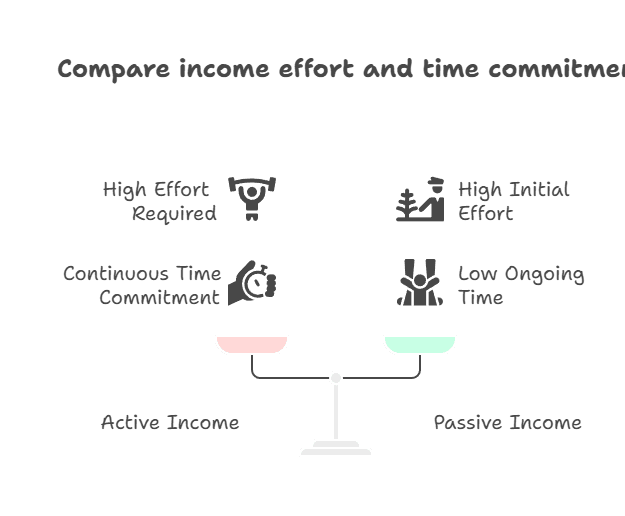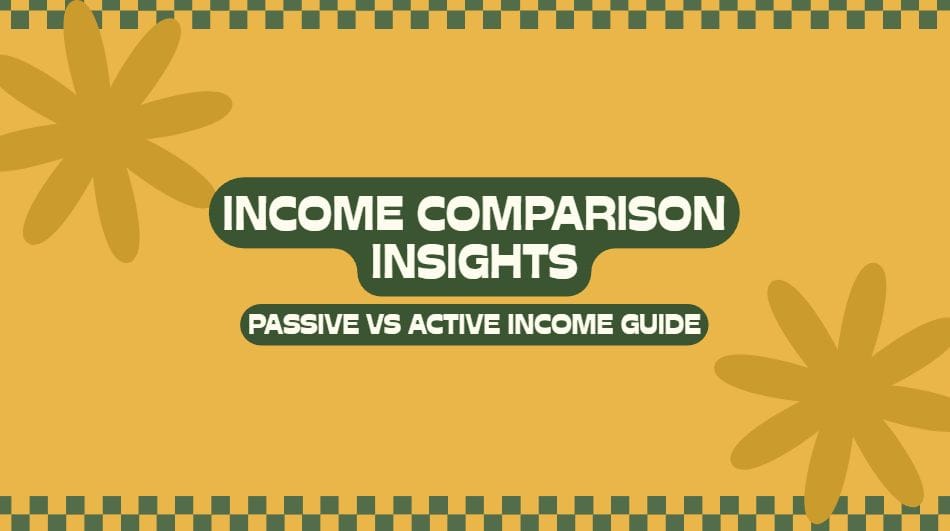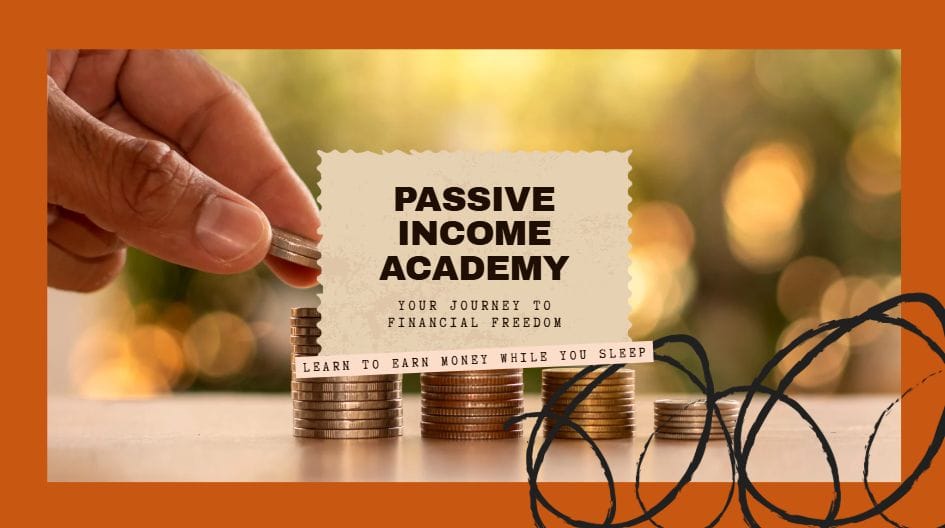Ultimate Guide: What Is Passive Income? 21 Smart Ways to Earn in 2025
Introduction
Imagine making money while relaxing, sleeping, or traveling across Europe with nothing but a backpack and a dream. Sounds like a fantasy, right? But in 2025, it’s not only possible—it’s becoming the norm for millions of people around the world.
Passive income is money you earn without constantly working for it. It’s different from your 9-to-5 job, where your paycheck stops the moment you do. With passive income, you build systems, assets, or investments once—and then continue to earn from them over time.
Thanks to technology, automation, and global connectivity, 2025 is the best time in history to build streams of passive income. Whether you’re a busy parent, a digital nomad, or someone looking to escape the paycheck-to-paycheck grind, there are more opportunities than ever before.
Think of things like affiliate marketing, dividend-paying stocks, renting out digital products, or even selling your online course. The options are endless—and many require little to no money to start.
In this guide, we’ll dive deep into 21 smart ways to earn passive income while you sleep, so you can finally take back your time and live life on your terms.
What Is the Meaning of Passive Income?
Definition and Examples
At its core, passive income is money you earn without having to trade your time for it every day. It’s not completely “hands-off” at the beginning—you usually have to put in some time, effort, or money upfront—but once it’s set up, it keeps generating income with little to no ongoing work.
Think of it like planting a seed. You water it, nurture it, and over time, it grows into a tree that bears fruit for years. That’s the beauty of passive income—it works for you even when you’re not working.
Here are a few common examples:
- Rental Income: Owning a property and collecting rent each month. While it may require occasional maintenance, it mostly runs itself.
- Digital Products: Creating an eBook, printables, or an online course once, then selling it over and over without doing more work.
- Dividends: Investing in dividend-paying stocks that send you a portion of a company’s profits regularly—no extra effort needed.
To better understand how passive income compares to regular (active) income, check out the table below:

Understanding the meaning of passive income is the first step toward financial freedom. It shifts your mindset from working harder to working smarter—building assets today that pay you tomorrow.
What Is the Difference Between Passive and Active Income?

Understanding the Key Differences
When it comes to earning money, not all income streams are created equal. The main difference between passive income and active income lies in how much time, effort, and risk you put in—and how sustainable that income is over the long term.
Active income is what most people are familiar with. It’s money you earn by trading your time directly for work. Think of jobs like freelancing, retail, or consulting—you have to keep working to keep getting paid. Stop working, and the money stops too.
On the other hand, passive income requires effort upfront but less ongoing involvement. Once your system or asset is in place, it keeps generating income with minimal day-to-day work. This income can be more sustainable because it doesn’t solely depend on you showing up every day.
Let’s look at a real-life example:
- Freelance Work (Active Income): You spend hours writing articles or designing websites. You get paid for every project, but if you stop taking gigs, the income dries up immediately.
- Selling an Online Course (Passive Income): You spend weeks or months creating a course. Once it’s launched, new students can buy it anytime without you actively working on it, providing a steady stream of income.
Here’s a breakdown to help clarify:
| Factor | Active Income | Passive Income |
| Effort | Continuous and high | High initially, low afterward |
| Time Investment | Ongoing daily/weekly | Mostly upfront |
| Risk | Depends on workload | Depends on investment/assets |
| Sustainability | Stops if work stops | Can continue without daily effort |
Understanding these differences is key to making smart financial choices. While active income pays the bills today, building passive income streams can give you freedom and security for tomorrow.
Is Passive Income Real or Just a Myth?
The Truth About “Making Money While You Sleep”
The idea of making money while you sleep sounds almost too good to be true—and that’s why many people wonder if passive income is just a myth. The truth? Passive income is very real, but it’s not magic or an overnight success story.
What often gets misunderstood is the amount of work needed at the start. Building a reliable passive income stream usually requires serious effort, time, or money up front. You might spend weeks creating an online course, months building a blog audience, or years investing in real estate. This setup phase isn’t “passive” at all—it’s hard work.
But once that foundation is in place, the money starts to flow with much less effort. That’s the part where “earning money while you sleep” becomes real. It’s about creating a system that works for you, even when you’re not actively working on it every day.
Take Sarah, for example, a graphic designer who created digital templates. After months of work, she now sells her templates online and earns a steady income every month without doing new designs regularly. Or Mark, who invested in dividend stocks years ago and enjoys quarterly payouts that add up steadily over time.
So yes, passive income is real—but it requires patience, persistence, and smart planning. It’s less about quick riches and more about building lasting financial freedom that grows quietly in the background of your life.
21 Best Passive Income Ideas to Start in 2025
Low-Investment Ideas for Beginners
Starting your journey to passive income doesn’t have to mean breaking the bank or having tons of experience. Many of the best passive income ideas in 2025 require little upfront investment—just your time, creativity, and persistence. Here are some beginner-friendly ideas that anyone can start with:
- Start a YouTube Channel
YouTube isn’t just for entertainment anymore. It’s become one of the most powerful platforms to build passive income. Pick a topic you’re passionate about—whether it’s cooking, tech reviews, or travel tips—and start creating videos. While it takes time to grow your audience, once you hit a certain number of subscribers and views, you can earn money through ads, sponsorships, and merchandise. Plus, your videos keep bringing in views (and money!) long after you upload them.
- Write an eBook or Online Course.
If you have knowledge or skills others want to learn, packaging that into an eBook or an online course is a fantastic way to earn passive income. Platforms like Amazon Kindle Direct Publishing or Teachable make it simple to publish and sell your content. You put in the hard work once—writing, filming, or designing—and your product sells itself continuously. Imagine earning money every time someone buys your course while you focus on your day job or hobbies.
- Affiliate Marketing
Affiliate marketing is like being a middleman between a customer and a product. You recommend products or services online through blogs, social media, or email lists. When someone buys through your special link, you earn a commission. It’s a low-cost way to start, and with the right niche and audience, affiliate marketing can become a significant source of passive income. For example, many tech bloggers earn thousands monthly by reviewing gadgets and linking to retailers.
- Sell Stock Photos
If you enjoy photography, selling your photos online can bring in a steady income. Websites like Shutterstock, Adobe Stock, and iStock allow you to upload your images and earn royalties every time someone downloads them. It’s a perfect example of how a creative skill turns into an ongoing paycheck—no need to chase clients or negotiate contracts once your photos are live.
- Print-on-Demand Stores
Imagine designing cool graphics or slogans and selling them on T-shirts, mugs, or phone cases—without ever handling inventory. Print-on-demand services like Printful or Redbubble print and ship your products when someone orders. Your job? Just create and upload designs. It’s low-risk because you don’t buy anything up front, and your store can keep selling 24/7.
These low-investment ideas show that making money passively in 2025 is within reach—even if you’re just starting. The secret lies in picking something you enjoy and sticking with it, knowing that every effort you put in now can pay off for years to come.
Investment-Based Ideas
If you have some money to put to work, investment-based passive income ideas can help you grow your wealth steadily over time. These options often require an upfront financial commitment but can reward you with consistent income streams—sometimes for years to come. Let’s explore some of the best investment-based ways to earn passive income in 2025.
- Dividend-Paying Stocks
Dividend stocks are shares in companies that regularly distribute a portion of their profits to shareholders. Instead of waiting to sell your stocks for a profit, you earn money simply by holding them. Dividends are usually paid quarterly, providing a steady income flow without selling your investments.
For example, utility companies, large banks, and consumer goods corporations often pay reliable dividends. Many investors reinvest those dividends to grow their portfolios faster—a powerful strategy called “compound interest.” While stock markets can be unpredictable, dividend investing remains a popular and proven method for building passive income.
- Real Estate or REITs
Owning rental property has long been a favorite passive income source. By renting out a house, apartment, or commercial space, you receive monthly rent payments that can cover expenses and generate profit. Of course, managing tenants and maintenance requires some work, but property managers can take care of those tasks for you.
If buying property directly feels overwhelming or too costly, consider Real Estate Investment Trusts (REITs). REITs are companies that own and manage real estate and pay investors dividends from the rental income. Buying shares in REITs allows you to earn real estate income without the hassle of being a landlord.
- Peer-to-Peer Lending
Peer-to-peer (P2P) lending platforms connect borrowers with individual lenders. Instead of a bank, you lend money to people or small businesses and earn interest as they repay the loan. Platforms like Prosper and LendingClub offer opportunities to diversify your investment by lending small amounts to many borrowers.
P2P lending offers attractive returns compared to traditional savings accounts or bonds, but comes with risk—borrowers may default on loans. Careful research and diversification are essential to minimize risks while enjoying this passive income avenue.
- Crypto Staking (Risk Disclaimer)
Cryptocurrency staking has become popular as a way to earn passive income by helping maintain blockchain networks. When you stake your crypto coins, you lock them in a wallet to support the network’s operations and receive rewards in return.
While staking can offer high returns, it’s important to remember that cryptocurrencies are highly volatile and risky. Prices can swing dramatically, and regulations are still evolving worldwide. Only invest money you can afford to lose, and research thoroughly before diving into crypto staking.
- Automated E-commerce Stores
Thanks to tools like Shopify and automated dropshipping services, running an online store can be a passive income source if set up smartly. Dropshipping allows you to sell products without holding inventory; when a customer orders, the supplier ships directly to them.
By automating customer service, marketing, and fulfillment, your e-commerce store can run with minimal day-to-day input. Though initial setup and marketing require effort, once the system is running, it can generate consistent sales and income around the clock.
Investment-based passive income ideas in 2025 offer many paths to build financial security and independence. Whether you prefer the steady reliability of dividends and real estate or the innovative potential of crypto and ecommerce, the key is to understand the risks and stay committed to your long-term goals. With patience and smart choices, your money can work for you, freeing up time to focus on what truly matters in life.
How to Start Earning Passive Income from Scratch
Step-by-Step Action Plan
Starting your passive income journey can feel overwhelming—but breaking it down into clear steps makes it manageable. Here’s a simple action plan to help you move from idea to income, whether you have more time or more money to invest.
Step 1: Choose Your Model (Time vs. Money)
The first decision is understanding what you can invest upfront. Do you have extra time but limited funds? Then focus on low-cost ideas like creating digital products, affiliate marketing, or building a YouTube channel. If you have some savings to invest, consider dividend stocks, real estate, or automated e-commerce stores. Knowing your resources helps you pick the right passive income path.
Step 2: Identify Your Skill or Capital
Look at what you bring to the table. Are you good at writing, designing, or teaching? Those skills can translate into ebooks, courses, or stock photos. If you have capital, think about investments that fit your risk comfort level—whether that’s stable dividend stocks or higher-risk crypto staking. Aligning your passive income strategy with your strengths or financial means increases your chance of success.
Step 3: Build, Automate, Scale
Once you’ve picked your idea and gathered resources, it’s time to create. Build your product, set up your investment, or launch your online store. After launching, focus on automation—use tools to schedule posts, manage sales, or reinvest earnings automatically. Finally, look for ways to scale, like expanding your course, adding more products, or diversifying your portfolio. Growth means more passive income over time.

How to Earn $100, $200, $1000, or $5000 Monthly in Passive Income
Scaling Strategies Based on Your Goals
Setting clear financial goals is crucial when building passive income. Whether you want to earn a modest $100 a month or a substantial $5,000, the effort and investment required will vary greatly. Here’s a breakdown of how you can scale your passive income depending on your target.
Earning $100 Monthly
At this entry level, low-investment and time-friendly ideas work best. For example, you could start a small affiliate marketing blog that earns commissions from a handful of sales each month or sell a few digital products like printables or stock photos. Alternatively, a small dividend stock portfolio worth a few thousand dollars might generate about $100 annually or monthly, depending on yield. This goal requires limited upfront cash and moderate effort.
Earning $200 Monthly
Doubling your passive income often means scaling your current efforts. For bloggers, this might involve publishing more content and optimizing SEO to attract more visitors, increasing affiliate commissions, and ad revenue. Dividend investors might expand their portfolio or add higher-yield stocks. If you’re into real estate, this could be a small rental property with positive cash flow after expenses.
Earning $1,000 Monthly
Reaching the $1,000 mark usually involves a combination of bigger investments and more strategic scaling. Bloggers or YouTubers often diversify income streams—adding sponsored content, paid memberships, or selling online courses. Investors may hold multiple dividend stocks or own rental properties with steady tenants. Building an automated dropshipping store with consistent sales is another way to hit this level.
Earning $5,000 Monthly
This level typically requires significant upfront capital or a well-established business. Real estate investors might own multiple rental properties or commercial spaces generating substantial cash flow. Dividend portfolios can be sizable, potentially in the six-figure range, to deliver this kind of monthly payout. Content creators with loyal audiences might sell high-ticket courses, coaching, or memberships. Success here often means combining multiple passive income streams.
| Goal | Strategy | Estimated Timeframe |
| $100/month | Affiliate marketing, small dividend portfolio, digital products | 3–6 months |
| $200/month | Increased content creation, expanded dividends, and rental income | 6–12 months |
| $1,000/month | Diversified income streams, multiple properties, and ecommerce | 1–3 years |
| $5,000/month | Large investments, multiple rental properties, scalable business | 3+ years |
By understanding the level of effort and investment needed at each stage, you can plan your passive income journey realistically. Remember, patience and consistency are your best allies—every dollar earned today can multiply into financial freedom tomorrow.
Best Skills to Learn for Long-Term Passive Income
Top In-Demand Skills That Keep Paying
Building passive income is easier and more sustainable when you master skills that are in high demand and can generate income repeatedly over time. Here are some of the best skills to invest in for long-term success.
Content Writing
Good writing never goes out of style. Whether you’re crafting blog posts, ebooks, or marketing copy, strong writing skills help you create valuable content that attracts audiences and drives sales. Great content is the foundation of affiliate marketing, course creation, and many other passive income streams.
SEO and Blogging
Understanding Search Engine Optimization (SEO) is a game-changer. SEO helps your content rank higher on Google, bringing steady, free traffic to your blog or website. When you master SEO, you can turn your blog into a passive income machine—earning from ads, affiliate links, and product sales without constantly promoting.
Graphic Design (for Products)
Design skills let you create eye-catching digital products like printables, templates, or merchandise graphics. These assets can be sold repeatedly with minimal extra work. Even simple designs for print-on-demand stores or stock photo sites can generate ongoing royalties.
Coding (Apps, Automations)
Learning to code opens doors to building apps, websites, or automations that work for you 24/7. Automating repetitive tasks or creating useful tools can generate passive income by solving problems for others, through subscriptions or one-time sales.
AI Tools for Automation
In 2025, AI is transforming how we work. Knowing how to use AI tools for content creation, marketing, customer support, and business automation can save time and boost your passive income. Automating routine tasks lets you focus on scaling your income streams without burning out.
Mastering these skills not only helps you build new passive income streams but also makes existing ones more profitable and easier to manage. Investing in your skills is one of the smartest moves you can make on the road to financial freedom.
Where Should Beginners Invest for Passive Returns?
Low-Risk Options That Grow Over Time
If you’re just starting with passive income, choosing low-risk investment options is a smart way to build steady returns while protecting your money. These investments might not make you rich overnight, but they grow steadily and build a solid financial foundation over time.
Index Funds
Index funds are a favorite among beginner investors because they spread your money across many companies at once. Instead of picking individual stocks, you invest in a broad market index like the S&P 500. This diversification lowers risk and lets you benefit from the overall growth of the market. Over the years, index funds have historically delivered consistent, reliable returns—perfect for patient investors seeking passive income through dividends and capital gains.
Micro-Investing Platforms
Not ready to invest large sums? Micro-investing apps like Acorns, Stash, or Robinhood let you start with just a few dollars. They often automate investing by rounding up your daily purchases or offering easy-to-use portfolios tailored to your goals. This approach helps you build an investment habit and gradually grow your passive income without feeling overwhelmed.
Digital Real Estate (Domains and Websites)
Buying and holding valuable domain names or small websites can be a surprisingly low-risk way to earn passive income. Domains with popular keywords can be sold later for a profit, while websites can generate income through ads, affiliate marketing, or product sales. Managing digital real estate requires some time and effort upfront, but it can pay off handsomely over the long term.
Courses or Digital Assets
Creating and selling digital courses or downloadable assets like templates and guides is another low-risk investment of your time and knowledge. Once built, these products continue to generate income with little ongoing effort. Platforms like Udemy, Teachable, or Etsy make it easy for beginners to start selling digital products quickly.
By focusing on these low-risk, steady-growth options, beginners can build confidence and create multiple passive income streams that grow safely over time—setting the stage for greater financial freedom in the future.
Disadvantages of Passive Income (What No One Tells You)
The Other Side of the Coin
While the idea of earning passive income sounds amazing, it’s important to understand the challenges behind the scenes—things that aren’t often talked about.
First, passive income usually demands a high setup time. Whether you’re creating a course, building a blog, or investing in stocks, the initial phase takes significant effort, patience, and learning. It’s not a quick fix; you might spend months or even years before seeing real returns.
Second, many passive income streams require technical skills. Managing websites, setting up automated systems, or understanding investment platforms can feel overwhelming, especially if you’re new to technology. Learning these skills is essential, but it can be a steep curve.
Third, there’s the challenge of delayed gratification. Unlike a paycheck that arrives every week, passive income often builds slowly. It takes time for your efforts or investments to generate steady cash flow, which can be discouraging if you expect fast results.
Lastly, market volatility risks can impact your income, especially with investments like stocks or cryptocurrency. Economic downturns or unexpected changes can reduce your returns or even cause losses.
Knowing these downsides helps set realistic expectations. Passive income is a powerful tool—but it’s not effortless or risk-free. The real reward comes from persistence, learning, and smart planning. Understanding both sides of the coin will prepare you better for the journey ahead.
Frequently Asked Questions
What qualifies as passive income?
Passive income is any money you earn without needing daily active effort after the initial setup. It means you put in work upfront—like creating a product or making an investment—and then continue to earn from it regularly without constant involvement.
What is another name for passive income?
Passive income is also called recurring income or residual income. These terms highlight that the money keeps coming in repeatedly, often with little ongoing work.
How to make extra money alongside my job?
You can start earning extra money through side projects like affiliate marketing, creating and selling digital courses, or generating ad revenue from blogs or YouTube channels. These methods allow you to build income streams that gradually grow while you keep your day job.
How can I make $100/day in passive income?
Making $100 a day passively usually means investing significant time in building online assets like blogs or courses, or having upfront capital to invest in dividend stocks, rental properties, or automated businesses. It requires patience and consistent effort or investment to reach that level.
What to invest in as a beginner for passive income?
For beginners, low-risk investments like ETFs (Exchange-Traded Funds) are a great start. Creating digital products, blogging, or investing in rental properties can also generate passive income over time. Start small, learn as you go, and diversify your income streams to reduce risk.
These answers give you a solid foundation to understand and start your passive income journey with confidence. If you have more questions, feel free to ask!
Conclusion
Passive income is very much real—but it’s not a get-rich-quick scheme. It takes time, effort, and patience to build the systems or investments that generate money while you focus on living your life. The good news? Everyone can start, even with low-risk, beginner-friendly ideas like affiliate marketing, digital products, or investing in index funds.
The key is to take that first step today. Don’t wait for the “perfect” moment—start small, learn along the way, and watch your passive income grow steadily over time. Your financial freedom depends on the actions you take now.
Ready to get started? Download our free passive income checklist and subscribe for expert tips and updates to guide you on your journey. The path to lasting wealth begins with a single step—make yours today!
READ MORE: 7 Powerful Benefits of Artificial Intelligence in Asset Management PDF






